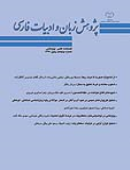تحلیل توازن آوایی در غزلیات «سلطان ولد»
محورهای موضوعی : پژوهشهای ادبیات کلاسیک ایرانزینب تاجیک 1 , وحید علی بیگی سرهالی 2
1 - دانشگاه بوشهر
2 - دانشگاه ارومیه
کلید واژه: توازن آوایی سلطان ولد شعر کلاسیک غزل موسیقی شعر,
چکیده مقاله :
موسیقی شعر عامل جذابیت متون نظم است. این عامل در غزلهای «سلطان ولد» جلوهای دیگر دارد که با عنوان توازن آوایی در قالب یادشده، نمود چشمگیری یافته است. شاعر با استفاده از توازن کمی در مبحث وزنی و استفاده از وزنهای مختلف، چاشنی ضرب و آهنگ غزلهای خود را افزایش داده است. سلطان ولد به کمک وزن دوری، جذبه و شور خاصی به غزل می بخشد، تا جایی که بیشترین بسامد وزن دوری را در استفاده از وزن تند و ضربی این قالب شعری مشاهده می کنیم. وی در کاربرد توازن آوایی کیفی، به انواع تکرار دست می زند و با تکرار انواع صامت و مصوتهای زبان فارسی، سعی در زیباسازی غزل هایش نموده است که استفاده وی از مصوت بلند «آ» از بسامد بالایی برخوردار است و از مصوت کوتاه «-ُ» در زمینه تکرار، کمترین بهره را برده است. سلطان ولد با استفاده از تکرار واکه و همخوان ها در آغاز و پایان واژگان، جلوهای آهنگین به اشعارش می بخشد که این بهره گیری شاعر از انواع تکرار در جایگاه قافیه از نمود بیشتری برخوردار است. بنابراین میتوان گفت که سلطان ولد با بهره گیری از انواع توازن در بخش هم صدایی و همحروفی با رعایت انواع همخوانها، موسیقی خاصی به غزل هایش بخشیده است که در زمینه های مختلف قابل بررسی است. این پژوهش با روش تحلیلی- توصیفی صورت گرفته، که ابتدا مباحث توازن آوایی را در غزلهای سلطان ولد شناسایی کرده، سپس ضمن تحلیل هر یک از آنها، بسامد هر کدام را در قالب نمودارها و جداول مشخص نموده ایم.
The music of poetry is what makes the verse interesting. This factor is manifested in a unique way in Sultan Walad Ghazals, which is highly represented in the phonetic balance. The poet has increased the variety in rhythm using quantitative balance regarding metric features and using different meters. Sultan Walad has created special kind of rapture and fascination in his Ghazals using the cyclic meter in a way that cyclic meter is most frequent in the fast rhythms of this kind of poem. In the application of qualitative phonetic balance, he uses repetition, and by repeating different Persian vowels and consonants he has increased the aesthetic feature of his Ghazals. The long vowel /a/ is very frequent while /o/ is the least frequent vowel in his use of repetition. Sultan Walad has created rhythmic aspects in his poems by the application of vowel and consonant repetition while the most frequent repetition is in the initial consonant and the least frequent is the repetition of the initial vowel and consonant. The poet's use of repetition is more obvious in the rhyme. Therefore, it can be said that Sultan Walad has created a special kind of music in his Ghazals using different kinds of balance, regarding same sounds (including consonants), and same letters which can be studied from different aspects. An analytical-descriptive method is used in this research through which we have identified phonetic balance in Sultan Walad’s Ghazals, and in addition to analyzing each, we measured and showed the frequencies using charts and tables.
